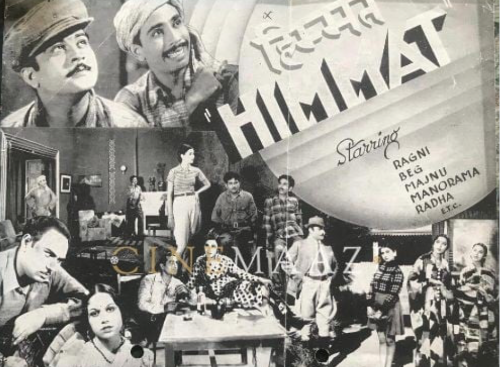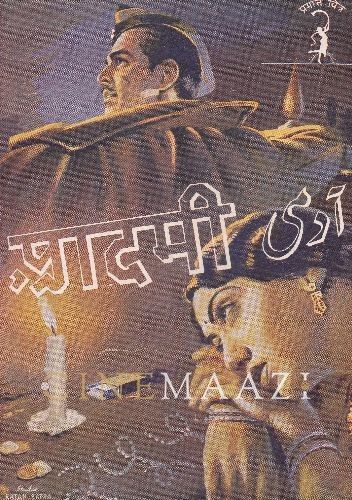Admi or Life's for Living
Produced by: The Prabhat Film Co., - Story by: A. Bhaskar Rao - Direction: V. Shantaram - Dialogues and Songs: Anant Kanekar and Munshi Ajiz - Music Direction: Master Krishna Rao - Cinematography: V. Avadhoot - Audiography: S. Damle - Cast: Shanta Haublikar, Shahu Modak, Bai Sundarabai, Buwa Saheb, Ram Marathe, Chhottu, Gouri etc.,-Released at: The Central Cinema, Bombay Date of Release: 9th September 1939.
This is undoubtedly the finest picture produced by any Indian Studio this year. After two years, Shantaram has come out with a real winner. For the social significance of its subject matter, the realism of its treatment, the perfection of its technique and the wealth of gripping dramatic elements. “Admi” will be difficult to surpass. In the opinion of many independent observes it is better than any other film seen this year in India - not excluding ‘hits’ from Hollywood, England. France and Russia!
The story of this film can be summed up in a few words. Moti, a young policeman, the son of a pious religious-minded but kind and gentle old woman, falls in love with Kesar, a ‘song-and-dance girl’ who has been forced into this life by forced of circumstances and who desperately wants to abandon this life. They decide to get married. Moti’s mother, a simple soul, gives her permission - not knowing the antecedents of Kesar. At the last moment, however, Kesar realizes that in such a pious household she would not fit in. she leaves the town. Moti, at first tempted to behave like all frustrated lovers, is saved by the commonsense advice of his colleague and friend, Meghram. Meanwhile tragedy that has been dogging the footsteps of Kesar overtakes her.
To judge “Admi” from this story would be like judging the beauty of a human from an X-Ray photograph showing only the skeleton of bones. It is the clever scenario of Bhaskar Rao that has endowed the story with a rich and stimulating variety of incident and given it point and purpose. And Shantaram’s direction has breathed into it a soul- the soul of Man!
Kesar is a ‘Song and Dance girl’. But she has a heart and a brain. She feels the indignity and humiliation of her position in life. She also understands (as few fallen women do) that she has been the victim of cruel circumstances and that fundamentally she is as good as any other human being. She upholds her self-respect by using irony and a healthy cynicism. But a human being is but a part of the social system and ultimately she has to voluntarily accept Society’s unspoken verdict on herself.
There are other interesting and significant characterizations Mannu, the boy of the slums; Meghram and his wife, representing love as the masses of India understand it; Moti’s mother - pious, gentle, affectionate and superstitious, a typical Indian mother; and the blood-sucking parasite to whom Kesar represents a perpetual source of money for drink. As variegated an assortment as you will invariably find in life itself.
Performances: The hero of the film is none else but Shantaram who has succeeded in getting uniformly good work out of his artistes. Shanta Hublikar who had not created a great impression in “My Son”, rises to heights of histrionic triumph in the role of Kesar. She brings to this characterization a wistful charm, a sparkling vivacity which has yet the traces of a tortured soul within, a natural gift for music. Her “Kis Liye Kal Ki Bat” song, sung in six languages (Hindustani, Gujarati, Bengali, Punjabi, Tamil and Telugu) will win her millions of fans from Kumbakonam to Rawalpindi, from Ahmedabad to Calcutta. Shahu Modak, appropriately ‘soft’ and boyish, reveals outstanding histrionic ability. Bai Sundrabai’s songs, especially “Man Pani Bhula kaun Ise Samjhaye’?” will be rummed all over India. Buwa Saheb is ‘natural’ for raising laughs and Gouri is already known for her characterization of an unsophisticated Indian housewife. The surprise of the film is provided by Ram Marathe who as Mannu, turns out a memorable performance and comes very near to stealing the show.
This article is a reproduction of the original published in Film India, October 1939.
Tags
About the Author
Baburao Patel was a film journalist and writer, primarily associated with the two publications Filmindia (1935-1961), which was the first English film periodical published from Bombay and the more politiccally inclined Mother India.







.jpg)


